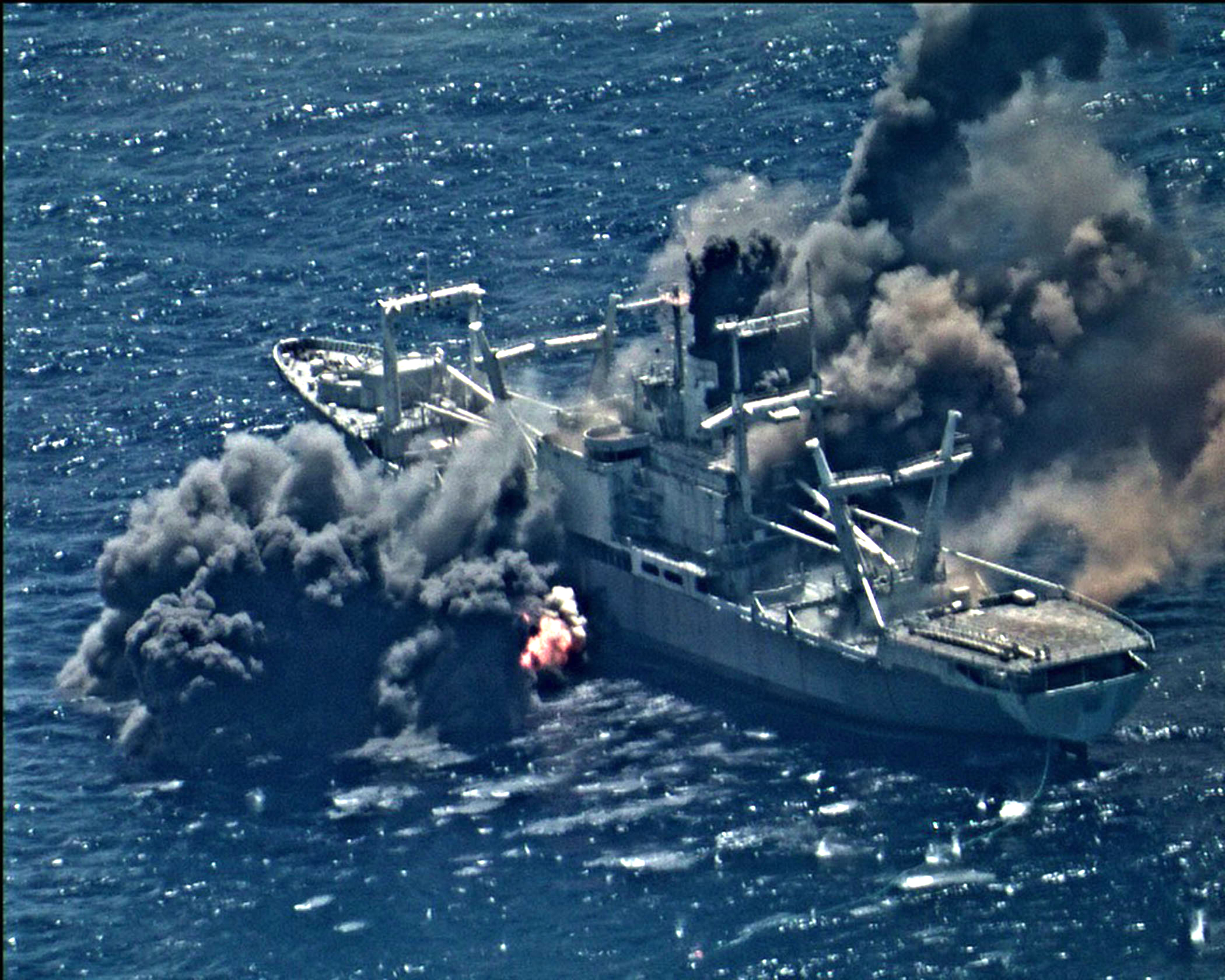
Live fire from ships and aircraft sink the decommissioned amphibious cargo ship ex-USS Durham August 30.
WASHINGTON: The missiles screamed in from surface ships, helicopters, aircraft and an attack submarine to rip huge holes in the retired Navy ship USS Durham on Sunday, sending the old vessel to the bottom of the Pacific.
The former cargo ship was sunk with a mix of Harpoon, Hellfire, and Exocet missiles, helped along by a torpedo and several 5-inch guns, all which which sent the old workhorse to the bottom in the traditional wrap up to the biannual RIMPAC exercise.
While this year marked one of the smallest RIMPAC exercises in recent memory thanks to COVID-19 restrictions, the international coordination in ripping the Durham to shreds in a matter of minutes accomplished the goal of getting a variety of warships and aircraft to mass fires quickly, and showcase some precision weapons.
A Navy video shows RGM-84 Harpoon ship-killing missiles launched by the Canadian frigate HMCS Regina and US destroyer USS Lake Erie tearing into the ship, along with a French-made Exocet missile fired by offshore patrol vessel KDB Darulehsan from Brunei, and an MK-48 torpedo from the Los Angeles Class attack submarine USS Jefferson City.
The Australian frigate HMAS Stuart and USS Chung-Hoon destroyer fired 5-inch guns at the ship. From the air, Australian and US Navy Seahawk helicopters shot Hellfire missiles at the doomed ship, along with an AGM-84 Harpoon missile launched by a Washington state-based P-8 surveillance aircraft from Patrol Squadron 46.
The Jefferson City’s MK-48, while deadly, is something of a return to the status quo after the USS Olympia Los Angeles-class sub launched a Harpoon at a sacrificial vessel during the 2018 RIMPAC exercise, marking the first time the missile had been fired from an American submarine since the sub-launched version of Harpoon was retired in 1997.
The 2018 RIMPAC also saw six more Harpoons fired from US and Australian P-8 aircraft and the Singaporean frigate RSS Tenacious. The exercise was the first time Australia has fired a Harpoon from a P-8. Japan also hit the 2018 ship with truck-mounted Type 12 anti-ship missiles, while the Army hit it with its truck-mounted High Mobility Artillery Rocket System (HIMARS).
A video released by the Navy of this year’s exercise shows several missiles slamming into the sides of the ship within seconds of one another, signaling close coordination between the international array of ships in the area.
“Simulation is a critical part of our training, but there is nothing better than to conduct live fire training,” said Royal Australian Navy Capt. Phillipa Hay, commander, RIMPAC 2020 Task Force One. “Sinking exercises are an important way to test our weapons and weapons systems in the most realistic way possible. It demonstrates as a joint force we are capable of high-end warfare.”
In total, this year’s exercise involved the navies of Australia, Brunei, Canada, France, Japan, South Korea, New Zealand, the Philippines, Singapore, and the US fielding a total of 22 surface ships, one submarine and 5,300 personnel. The Canadian frigate HMCS Winnipeg also fired Harpoons during the exercise, though it didn’t take part in the Durham sinking.
Originally, RIMPAC 2020 was planned to include up to 30 countries, more than 50 ships and submarines, more than 200 aircraft, and 25,000 personnel, making it the largest RIMPAC to date. We’ll see about 2022.






















